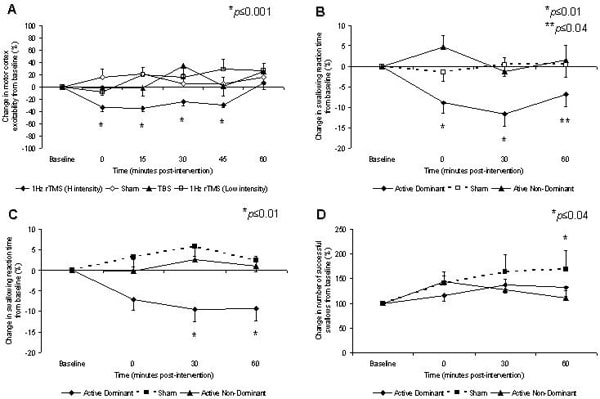Background: Cortical control of human swallowing is bilateral with hemispheric asymmetry in motor cortex. However, the physiological relevance of this asymmetry remains unclear. Repetitive transcranial magnetic stimulation (rTMS) can be used to induce targeted ’virtual lesions’ of brain regions (1, 2). We applied inhibitory rTMS to the swallowing motor cortices (‘dominant’ (D) and ‘non-dominant’ (ND)) to establish whether such inhibition could result in behavioural changes in swallowing function. Methods: Single pulse TMS combined with pharyngeal motor evoked potentials (PMEPs) (recorded via an intraluminal catheter) were used to assess swallowing excitability. The hemisphere evoking the largest PMEPs was termed D, and contralateral ND. Effects on PMEPs were measured before and up to 1 hour after two inhibitory rTMS paradigms: 1Hz rTMS (n=9; 6M/3F, mean age 34) and theta burst stimulation (TBS) (n=9; 6M/3F, mean age 37) delivered in a randomised, double blind order on separate days). In a separate set of studies (n=8; 5M/3F, average age 36), a swallowing reaction time task was used to assess the effects of inhibition (to each hemisphere) on swallowing function and comprised 3 cued tasks: normal, fast and challenged swallows (within a 150ms time window). Measurements were taken before and up to 1 hour after 10 minutes of 1Hz rTMS (active stimulation to D and ND hemispheres and sham, randomised, double blind, separate days). Baseline vs. hemispheric intervention data were analysed using repeated measures ANOVA. Results: (Fig A) High intensity 1Hz rTMS to D dramatically suppressed excitability immediately and up to 45 minutes (-34±14%, p≤0.001). Ipsilateral hand motor cortex showed a transient but non-significant decrease in responses (-15±12%, p=0.14) post-rTMS whereas contralateral hemisphere (ND) showed no change (15±12%, p=0.45). By comparison, low intensity 1Hz, TBS and sham rTMS interventions had no effect. Moreover, active 1Hz rTMS to D demonstrated a reduction in both normal (Fig B, -12±3%, p≤0.01) and fast (Fig C, -9±4%, p≤0.018) swallow reaction times compared to baseline whereas active rTMS to ND and sham had no effect. In comparison, challenge swallows (Fig D) showed a (predicted) rise in successful trials following sham (p<0.041) but no change following active rTMS of either hemisphere. Conclusions: Our data show clear differences in swallowing motor cortex excitability and behaviour to a virtual lesion of each hemisphere, providing novel evidence for functionally relevant asymmetry in the cortical swallowing motor system.
Life Sciences 2007 (2007) Proc Life Sciences, PC425
Poster Communications: Modulation of human swallowing function by a virtual lesion to healthy motor cortex
S. Mistry1, E. Verin2, S. Jefferson1, S. Singh1, D. G. Thompson1, J. C. Rothwell3, S. Hamdy1
1. Gastrintestinal Sciences, University of Manchester, Manchester, United Kingdom. 2. Department of Physiology, University of Rouen, Rouen, France. 3. Sobell Department of Motor Neuroscience and Movement Disorders, Institute of Neurology, London, United Kingdom.
View other abstracts by:
Where applicable, experiments conform with Society ethical requirements.

